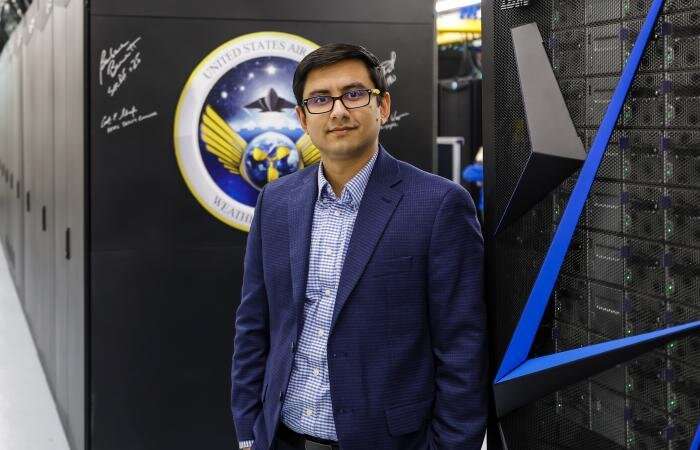This article has been reviewed according to Science X's editorial process and policies. Editors have highlighted the following attributes while ensuring the content's credibility:
fact-checked
trusted source
proofread
Analyzing a flood of data to prepare for climate change

Climate change often comes down to how it affects water, whether it's for drinking, electricity generation, or how flooding affects people and infrastructure. To better understand these impacts, Oak Ridge National Laboratory water resources engineer Sudershan Gangrade is integrating knowledge ranging from large-scale climate projections to local meteorology and hydrology and using high-performance computing to create a holistic view of the future.
In one of his recent projects, Gangrade conducted national-scale hydrologic modeling to study climate change effects on federal hydropower resources. The project analyzed 132 federal facilities that make up about 40% of the nation's hydropower generation capacity.
To better predict how those facilities will be affected by climate extremes, Gangrade and his fellow researchers in ORNL's Environmental Sciences Division translated global climate change predictions to impacts on local hydrology. The assessment used several models to look at future streamflow, hydropower operations and reservoir evaporation. The multiple-model approach provides insights to help federal hydropower facilities prepare for uncertainties in a changing climate, and will soon be expanded to nonfederal stakeholders.
"The hydrologic cycle is intensifying, and we can expect more extremes in the future," Gangrade said. "This study provides helpful data for hydropower operators so they can better manage their reservoirs."
Solutions for an advanced flood warning system
In another project, Gangrade is helping create a global flood forecasting capability using a model called TRITON, or Two-dimensional Runoff and Inundation Toolkit for Operational Needs, for the U.S. Air Force. The tool, created by ORNL and Tennessee Technological University, incorporates precipitation and stream flow routing to simulate floods. The capability will be scaled to a 10-meter resolution, roughly the scale of a tennis court, to provide fine detail for researchers. Gangrade and colleagues have simulated several flood events such as Hurricane Harvey using TRITON, as well as other global flooding events.
Gangrade is also integrating machine learning methods to develop hybrid reservoir operation models. He is using machine learning to detect historical reservoir operation patterns and create better long-term water management simulations.
He will soon take on the role of principal investigator for a new project combining his expertise in hydroclimate assessments and inundation models to assess flood vulnerability for Department of Defense facilities. The ensemble-based flood modeling will be conducted using downscaled climate projections to help identify vulnerable infrastructures in current and future climate scenarios.
In the long term, Gangrade would like to see his efforts integrated into a real-time flood forecasting and early warning tool for the general population.
"Climate change is already leading to more extreme events. We're likely to see an increase in flooding frequency as well as severity," Gangrade said. "What we're developing now at ORNL gives us a much better understanding of water dynamics in the future."
The next step is to come up with a better warning system for society so people have more time to evacuate, for better emergency planning and response, and for solutions that can be put in place now to make communities more resilient, he said. "That's where our inundation capability can come into play. It is a very efficient and accurate tool."
Hometown drought sets a career in motion
It was an undergraduate experience studying a multi-year drought in central India involving his hometown of Ujjain that piqued Gangrade's interest in hydrology and led him to pursue graduate degrees in the United States.
While studying environmental engineering at the Indian Institute of Technology (formerly the Indian School of Mines) in Dhanbad, he worked as an intern on a Clemson University-led project in India for two summers under a Society of Exploration Geophysicists program called Geoscientists Without Borders.
"That project introduced me to watershed hydrology and geophysics and applications for improving water resource sustainability," Gangrade said. "It motivated me to eventually pursue graduate studies at Clemson," where he earned a master's degree in environmental engineering and science.
He then worked at a private environmental and geophysical consulting firm for a couple of years before coming to ORNL as a postmaster's research associate in 2014.
While at ORNL, Gangrade earned his doctorate in environmental and climate sciences at the University of Tennessee where he was a fellow of the Bredesen Center for Interdisciplinary Research and Graduate Education under the UT-Oak Ridge Innovation Institute.
Away from the lab, Gangrade enjoys playing the keyboard and spending time with his young son.
Big science teams equipped with big science tools
At ORNL, Gangrade said he enjoys the interdisciplinary environment that lets him collaborate with other researchers in climate and data science. "And then there's the supercomputing here at ORNL," he said. "There's nowhere else that offers the kind of capabilities we have."
His advice for scientists just starting out? "All of the science problems we're challenged with are very interdisciplinary in nature," he said. "So I would advise them to be aware of different disciplines and to get internship experiences in various science areas. Internships were a big help for me, as my experience with Clemson in India and then my work with the consulting firm played a big role in my career."
Gangrade is motivated by what his work can mean to society at large. "Flooding impacts all of us," he said. It can turn areas of water scarcity into flood zones like in California. "I like that my research can build sustainable solutions to help everyone."
Provided by Oak Ridge National Laboratory





















